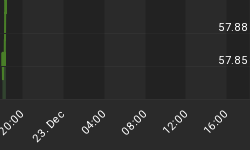Many economists hold to the view that when the NAICU (non-accelerating inflation rate of capacity utilisation) reaches 82 per cent inflation will pick up in the US economy. Capacity utilisation for last March was nearly 82 per cent. This figure is giving some economists heartburn.
The thinking here is that when utilised capacity reaches 82 per cent prices will begin to rise because output will no longer be able to keep up with demand. Shortages of factors will emerge and wages will rise as firms compete for against each other for labour. A rather novel variation of this explanation has emerged. It holds that because the world has opened up enormously during the last 20 years the idea of using capacity utilisation as an indicator of future trends in prices has been rendered obsolete.
People who subscribe to this view do not understand that labour shortages and bottlenecks were never indicators of future inflation because they are in fact caused by inflation. More than 175 years ago John Stuart Mill described the frenzied process of the boom as such that ". . . [when] they have built mills and erected machinery, they will be likely to repent at leisure".
Of course, our current crop of economic forecasters would not dispute Mill's account but simply declare that things are different today. These will invariably be the same economists who announced that the 1990s boom heralded "a new era"-- the very same thing Irving Fisher said about the 1920s boom.
And what make today different? According to their analysis it is the entry of hundreds of millions of workers from China, Russia and India into the world market place. This rapid expansion of the international labour force makes any notion of emerging labour shortages look absurd. Should domestic demand outstrip the labour supply firms will be able to depress wage pressure by using foreign labour and so avert inflation.
What advocates of this view do not grasp is that this policy is not averting inflation but is actually exporting it: a fact that could have grave consequences for other countries. By using artificially low interest rates to flood the economy with 'cheap' credit the Fed triggered the boom. It's this monetary expansion in the form of credit that is generating labour shortages and causing bottlenecks to develop.
This process also causes nominal incomes to rise, the effect of which is to increase the demand for imports. So rather than complementing America's capital structure and adding indirectly to its labour market these imports are really the product of a highly inflationary policy. To put it bluntly: this 'income effect' is really a symptom of a failed monetary policy.
By raising Americans' demand for imports the monetary expansion distorts the pattern of production of the exporting countries. In response to increased demand from the US these countries redirect a great deal of their capital to satisfying American consumers. When the Fed eventually applies the monetary brakes demand falls off and these exporting countries find themselves with idle capacity and rising unemployment.
(Of course, the amount of idle capacity and unemployment will be related to how much of the country's capital structure has been diverted to meet American demand).
But the process doesn't stop there. Most trade between countries takes place because of price differences. Now inflation disarranges prices and by doing so it distorts, as I have just explained, the pattern of production. But the same thing also happens in the US. By artificially increasing demand for exports by distorting price differences the US can unintentionally make domestic firms uncompetitive, forcing them to either close down or move abroad.
When this happens advocates of free trade cheerfully tell us that we are merely witnessing comparative advantage in operation and that this is a benign process that will eventually benefit us all by making the world a more productive and wealthier place. But they are wrong. This is not comparative advantage at work but forces driven by inflation that have warped the structure of capital and prices.
For free trade cannot work smoothly in the absence of sound monetary policies. It is unsound monetary -- meaning inflationary -- policies that cause financial crises, frenzied speculation, volatile exchange rates, etc. And who gets the blame for these economic fiascos? Capitalism.
These kinds of international problems were virtually nonexistent when the world was on a gold standard. The reason should be obvious: Politicians and central banks cannot manufacture gold. The only time during the gold standard period that Britain suffered a financial crisis was when the country experienced a gold drain caused by the banking system deviating from the gold standard. When that happened the Bank of England would raise the discount rate and reverse the flow.
What is truly depressing about the current situation is that all of this was argued in detail during the "bullion debate" that took place from 1800 to about 1811. If our economic analysts dedicated some of their precious time to studying economic history and the history of economic thought the world would be a much better place.
No wonder I am getting truly tired of free trade advocates who will not do their homework.















